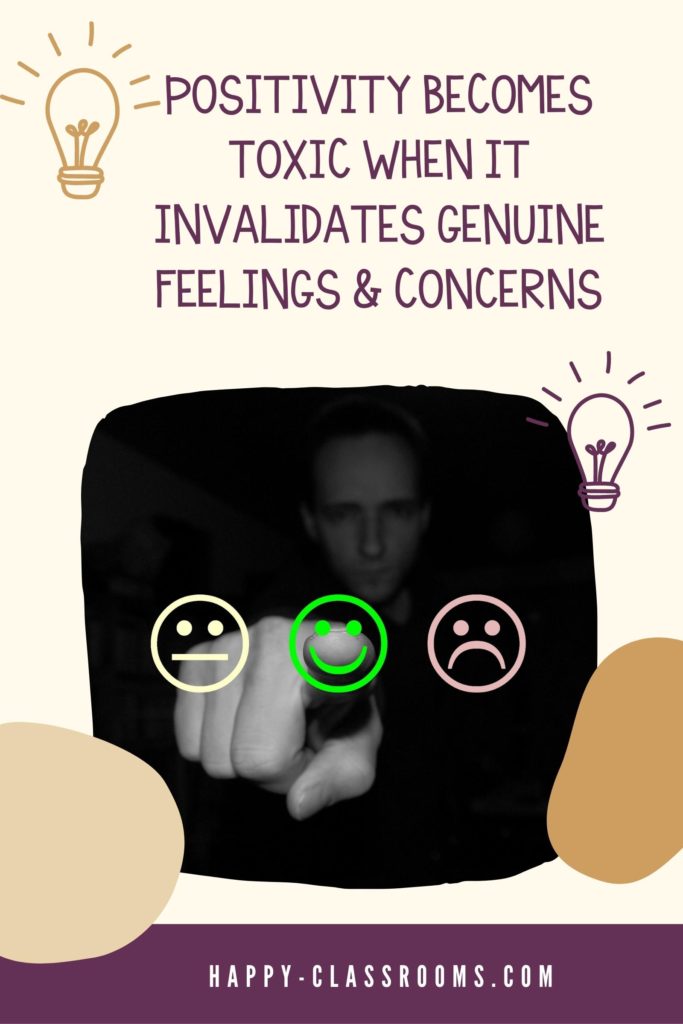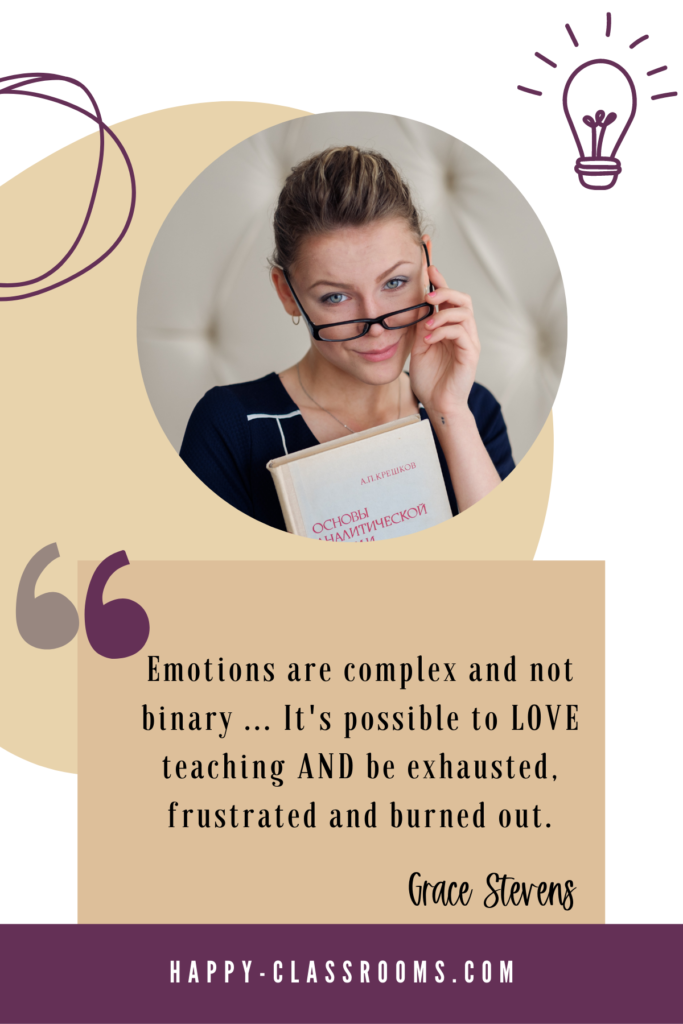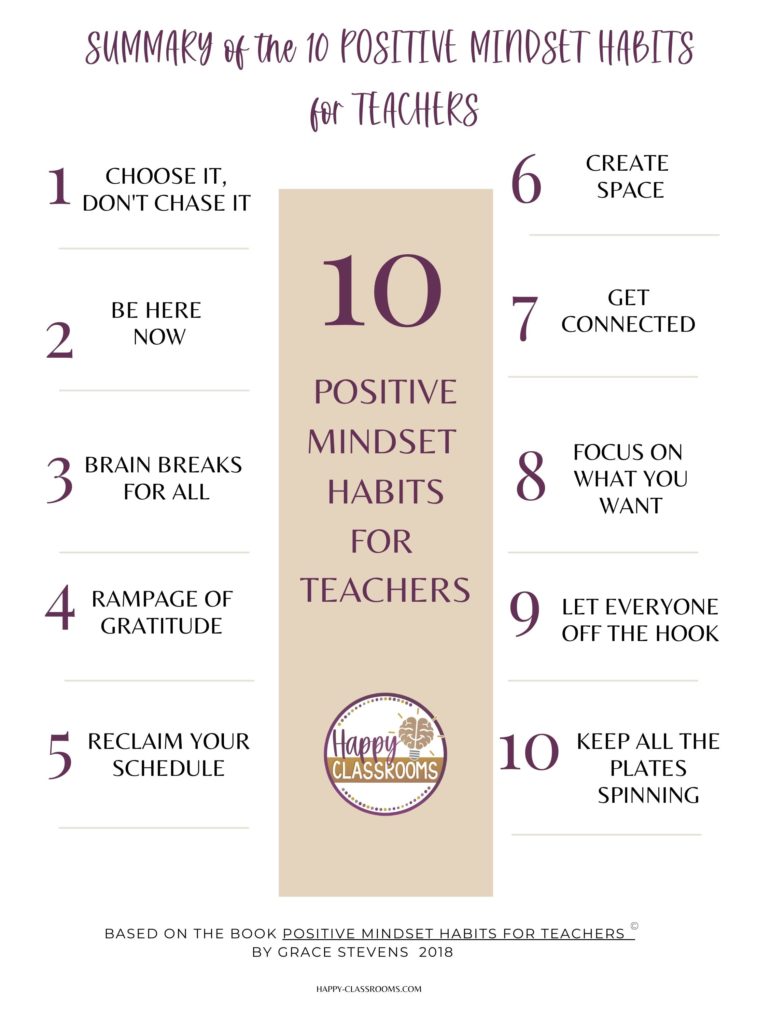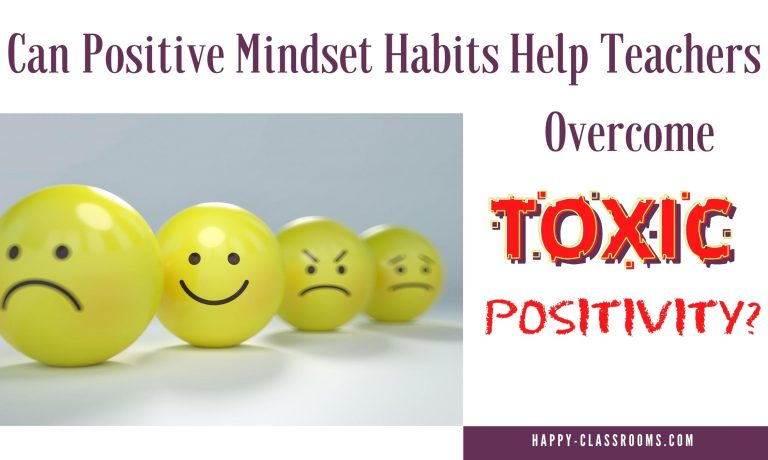Is Toxic Positivity Real or the latest “Buzz Word”?
Let’s get right to it – the foundation of my work in helping educators have a more positive teaching experience is to focus on positive mindset habits for teachers. However, a recent “anti-positivity” trend has surfaced on social media platforms, citing “toxic positivity” as rampant and damaging in education.
So what is toxic positivity? (Yes, it is a real thing.) Why is it damaging? And how is it different from authentic positivity, optimism, and proactively protecting our peace and happiness that I teach? These are the ideas I will be exploring in this blog post.
Before we dive in, I invite you to grab a free tool I have developed to help you have a more positive teaching experience. Based on simple practices that are scientifically validated, a 6-week PDF version of my Positive Mindset Habits Journal for Teachers can be found here
Toxic Positivity – Definition
The idea that anything can be overcome with the right attitude seems harmless enough. But when that attitude is weaponized to invalidate peoples’ genuine feelings and stress around real problems, then it becomes toxic. https://thepsychologygroup.com/ describes toxic positivity in the following way:
“The excessive and ineffective overgeneralization of a happy, optimistic state across all situations. The process of toxic positivity results in the denial, minimization, and invalidation of the authentic human emotional experience.”
Toxic positivity manifests in subtle and overt ways, and it is a growing issue on school campuses.
Toxic Positivity in Education
So what does toxic positivity look like in schools? Isn’t it appropriate for school cultures to be positive and optimistic?
While optimism is definitely helpful, many well-meaning administrators project toxic positivity when they say things such as:
- “We’re all in this together!”
- “We’re in it for the kids!”
- “It could be a lot worse; at least we have jobs!”
- “Be sure to take care of yourself, you’ll be less stressed!” or the worst,
- “Good vibes only!”
Basically, any type of comment or attitude that seeks to either consciously or unconsciously invalidate teachers’ feelings or avoid having an uncomfortable discussion about the many tough challenges they are currently facing.

To quote Dr. Susan David, author of Emotional Agility,
“Toxic positivity is forced, false positivity. It may sound innocuous on the surface, but when you share something difficult with someone, and they insist that you turn it into a positive, what you’re really saying is my comfort is more important than your reality.”
While toxic positivity is a new buzzword, the issue has been present in education for a long time. I frequently point out in my writing how unhealthy it is that we glamorize the “teacher martyr myth” through memes and jokes. The number of insane hours and the ever-increasing responsibilities piled on us as teachers should be neither considered humorous nor revered as a badge of honor.
So what’s the solution?
The Dark Side of Positivity versus Genuine Optimism
First, there needs to be a recognition that everything is NOT okay in education right now. More importantly, teachers need to feel VALIDATED and not GUILT RIDDEN when they utter these feelings.
While constant complaining without looking for solutions is equally toxic, no real conversation about improving things can occur until administrators, school boards, and school districts are willing to acknowledge that the issues we face are existent, pervasive, and damaging.
It is essential to recognize that these are complex issues and complex issues are not binary. Conflicting emotions can co-exist.
- It is possible to love teaching AND be overwhelmed and burned out by it.
- It is possible to love students AND be frustrated and exhausted by the recent and dramatic uptick in disruptive classroom behaviors.
- It is possible to respect our school and administrators AND want them to support us better.

Teachers need to be given space to experience these emotions without feeling guilt and to voice these emotions without being labeled as “difficult” or “negative.”
Like the students in our care, we need to feel heard and validated.
Of course, there is a time and place for optimism and working together to create a better future for our students, teachers, and schools. But there is ALSO a time and a place in education to acknowledge that what we do is hard and gets more demanding every year.
In addition to validation, we need administrators to truly support us, step up, advocate for us, and take responsibilities off our plate, not host a professional development on “self-care” and hand out “We got this!” mugs.
Teachers need to feel as positive and supported as possible despite the challenges. Here’s why.
The Importance of Positive Classrooms
In my writing, a common theme is that our energy teaches more than our lesson plans. Students pick up on our energy, regardless of what we’re saying. The extent to which students learn and have a successful day in class has less to do with the adopted curriculum, access to technology or class size, and more to do with whether they like us, want to please us, are happy to be in the classroom with us, and believe that we are happy to be there too.
Students can sense when teachers are frustrated, overwhelmed, and burned out. Everything feels like a struggle when we feel this way, and it is difficult to do our best teaching. When we feel passionate, connected, and appreciated, we have the motivation and energy to find creative and engaging ways to present material. Students are more on task, behavior interruptions are minimized, and the day goes smoother for everyone.
Simply stated, a positive classroom environment is essential for students to feel validated, engaged, and perform at their best.

Positive Mindset Habits for Teachers – Your Secret Weapon
When I wrote Positive Mindset Habits for Teachers back in 2018, I laid out the specific habits teachers could use to synthesize their own happiness despite the challenges in their classrooms and on their campuses. The scientifically validated practices were based on more than 15 years of real-world classroom experience and my study and certification in Neuro-Linguistic Programming and positive psychology. The habits are easy to implement and have helped thousands of educators transform their teaching experience.
I am still in the classroom. I’ll be honest since 2018, it seems that teaching has gotten exponentially more challenging and demanding. The positive mindset habits I teach are not about slapping an “Everything is okay!” sticker on the challenges and invalidating teachers’ feelings of frustration, overwhelm and fear for the future. Instead, their focus is, given how hard teaching is right now, how can we take responsibility for bringing the best of ourselves to our students end crafting a more positive classroom experience for all of us.
The ten habits in the book can help you feel more empowered and effective and help you rediscover the passionate excitement that made you want to become a teacher in the first place. Part of that may well involve learning to minimize contact with toxic people and toxic school cultures, but NONE of it is about being toxically positive.
I have summarized the ten habits in this infographic. Feel free to share it with as many teachers as possible. If you haven’t already read or listened to it, I invite you to grab Positive Mindset Habits for Teachers and the free workbook that comes with it at this link or any of your other favorite online retailers.
Conclusion – Toxic Positivity Is Real – Positive Mindset Habits for Teachers Can Help
Toxic positivity in education is undermining the potential of our students and killing teacher morale. It’s time to eliminate the forced smiles, obligatory happy-talk, and overwhelming sense of cheer that are suffocating authentic expression and honest communication. Let’s create a new positive paradigm for education that allows for authenticity, vulnerability, and genuine connection. Practicing positive mindset habits for teachers is not a “quick fix,” but it certainly will help teachers and students feel more empowered, optimistic, and inspired to do their best.
For more opinions on toxic positivity in education, check out these articles:
https://www.edsurge.com/news/2021-09-13-how-toxic-positivity-demoralizes-teachers-and-hurts-schools
https://www.educationworld.com/teachers/how-resist-toxic-positivity
Help out a teacher! What’s your favorite positive mindset habit for teachers? What have you tried, and how has it helped?



